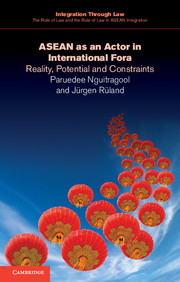Book contents
- Frontmatter
- Contents
- List of tables
- General editor's preface
- Acknowledgements
- List of abbreviations
- 1 Introduction
- 2 Analytical framework: a cognitive approach of externalization
- 3 ASEAN's cognitive prior and negotiating capacities
- 4 ASEAN as a negotiator in global fora: stages of negotiation
- 5 ASEAN as an actor in global fora: negotiation strategies
- 6 Case studies
- 7 Conclusions and future options
- Executive summary
- References
- Index
Executive summary
Published online by Cambridge University Press: 05 May 2015
- Frontmatter
- Contents
- List of tables
- General editor's preface
- Acknowledgements
- List of abbreviations
- 1 Introduction
- 2 Analytical framework: a cognitive approach of externalization
- 3 ASEAN's cognitive prior and negotiating capacities
- 4 ASEAN as a negotiator in global fora: stages of negotiation
- 5 ASEAN as an actor in global fora: negotiation strategies
- 6 Case studies
- 7 Conclusions and future options
- Executive summary
- References
- Index
Summary
This book addresses a topic that in the proliferating literature on the Association of Southeast Asian Nations (ASEAN) has so far been almost entirely neglected. While ASEAN's practices in intra-regional cooperation are well covered and some information exists about ASEAN's agency in international forums of the East Asian and Asia-Pacific region, hardly anything is known about ASEAN as an actor and negotiator in global forums such as the United Nations, the World Trade Organization (WTO), the International Monetary Fund (IMF) or the climate change and non-proliferation regimes. Available information is unsystematic, scattered and often anecdotal.
In this study, we argue that in global forums regional cohesion has to contend with four major constraints: first, the ASEAN Way as the grouping's repository of shared cooperation norms and, second, as a direct outflow of the former, ASEAN's organizational structure. Neither ASEAN's value system nor its internal structure is conducive to collective action in the global political arena. Both are legacies of a “cognitive prior” shaped by centuries of conflict, threats, instability and political uncertainties that have deeply engrained distrust, suspicion and ill-feelings towards the external world in the minds of decision-makers and major parts of the public. These legacies are reflected in the strong emphasis of the ASEAN Way on sovereignty norms. The seemingly cosmopolitan liberal norms ASEAN adopted with the Bali Concord II of 2003 and elevated to quasi-constitutional status in the ASEAN Charter enacted in 2008 may have eased external normative pressures on ASEAN, but have done little to overcome ASEAN's cohesiveness dilemma. On the contrary, they have, and this is our third major point, exacerbated the association's collective action problems by creating a value base that is contradictory below the surface of rhetorical unity. Fourth and finally, we argue that Southern regional organizations such as ASEAN also grapple with an uneven institutional playing field.
- Type
- Chapter
- Information
- ASEAN as an Actor in International ForaReality, Potential and Constraints, pp. 273 - 279Publisher: Cambridge University PressPrint publication year: 2015

